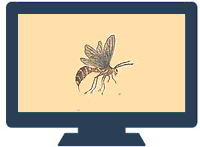Entomology, Department of
Date of this Version
2022
Document Type
Article
Citation
M.S. Final Project, Department of Entomology, University of Nebraska-Lincoln, 2022.
Abstract
Pyrethrum is an insecticide created from the dried flower heads of plants in the genus Chrysanthemum. The six compounds responsible for the insecticidal activity are collectively known as pyrethrins, and are known individually as Pyrethrin-I, Pyrethrin-II, Cinerin-I, Cinerin-II, Jasmolin-I, and Jasmolin-II. Of these compounds, Pyrethrin-I is best known for mortality, and Pyrethrin-II is best known for knockdown activity (Sisay et al. 2001). These compounds are voltage gated sodium-ion channel disruptors acting on nerve cells. The inside of nerve cells is negative relative to the outside at rest. It is due to an imbalance between ions on either side of the cell membrane, creating a membrane potential, I.E. a high level of potassium and a low level of sodium inside the cell and more sodium than potassium outside the cell, and internally higher concentration of non-diffusible anions. When an action potential occurs after a stimulus, the membrane potential is temporarily reversed, allowing for sodium ions to enter the nerve cell through voltage-gated sodium channels and causing the nerve to fire. The level of sodium then begins to decrease, and potassium increases by active transport (K+/Na+ pump), returning to the ion concentrations of the cell’s resting level after a brief hyperpolarization. Pyrethrins work by prolonging the open state of the voltage gated sodium channel, leading to paralysis (knockdown) and eventually mortality (Narahashi, T. 1971). If the concentration of pyrethrum is not high enough to cause knockdown, the insect can potentially leave the treated area (repellency) after experiencing sublethal effects. Pyrethrins are also known to be relatively harmless to mammals, especially when compared to other plant-based compounds (Maia and Moore 2011). It has an LD50 value of 1,200 to 1,500 mg/kg in rats. Nicotine by comparison has an LD50 value of 50 to 60 mg/kg in rats (Ware, G.W. 2000).
This review looks at the history and importance of pyrethrum as a repellent, test methods used to understand repellency, as well as the mechanisms responsible for causing an insect to be repelled. It focuses on urban and medical pests and the efficacy against them, as these pests tend to be disease vectors, or mechanical transmitters of disease, and have the highest need to be repelled.


Comments
Copyright © 2022 Gary Frazier